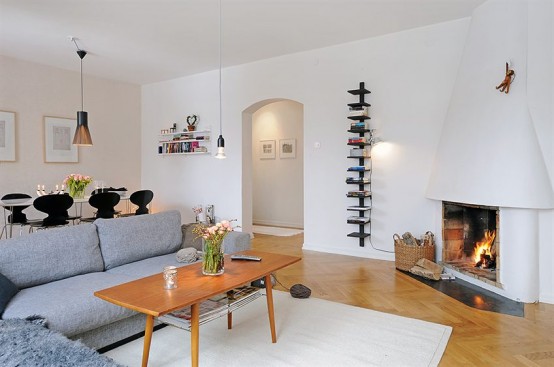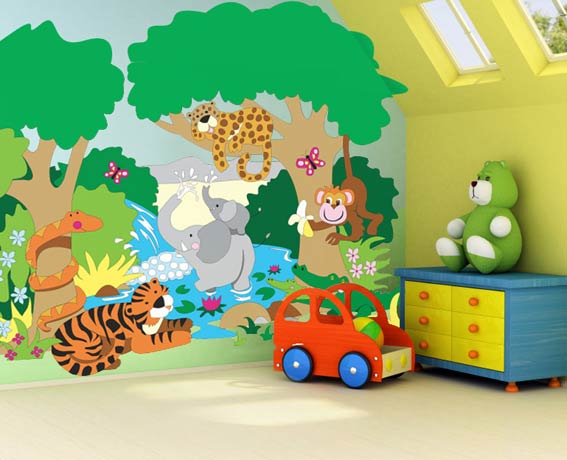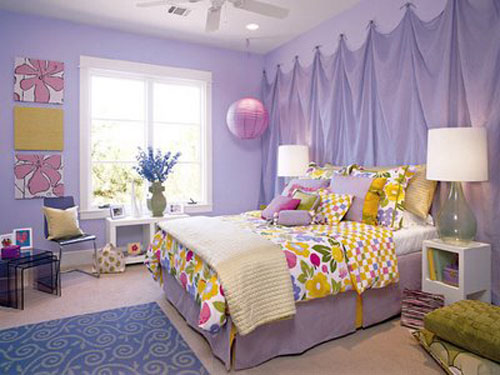Walls are an extremely important part of a room.The color or pattern you use on the walls can easily become the dominant part of a room, because of the large amount of space covered.Decide if you want the pattern in a room to be on the wall, the furniture, a rug, or a lavish window treatment.Typically, two very bold patterns in one space will fight each other and will not create a harmonious room.
When you think of color on the walls, don’t rule out all the possibilities.You can expand the feel of a room and add architectural interest to a plain room by adding a mural to the space, such as the tree and faux stone door mouldings added to the kitchen wall.
Flaws in the wall can be disguised depending on the sheen of the wall finish.The flatter or more matte the finish, the less the flaws in the plaster or drywall will show.If there are quite a few bumps or ridges in your dry wall surface, you should go with flat or satin finish, avoiding any shine.Flat and matte paints also allow furniture and wall decorations to become the focal points in the room.
Entrances, foyers, guest baths, and corridors are transitional parts of the house, and those walls can be bolder or darker than areas in which you spend a great deal of time. A bolder or darker color will also help a small space make a bigger visual impact.
If you have a dark room that doesn’t receive much sunlight, paint the walls in a light color satin or semi-gloss paint. The reflective surface, along with a lighter color, will reflect more light into the room.
Choosing Paint Colors for Walls
While considering decoration, picking a wall color can really be a challenge as the wall color will set the tone for the house. Actually, choosing a wall color should be the easiest work, but it turns into a hard decision because of so many possibilities. While selecting color, you will find that there are hundreds of choices you are bound to find the right color; you may go down with the mood, as there are so many choices and you don’t understand where to begin! The below tips will help you in the above tense condition.
- To start with you should see the purpose of the room which you are decorating such as living room, dining room, and the kitchen. These are social rooms which will look better with warm colors. The study room, main hall of the house, and bedrooms will look better with cool colors.
- Pick a warm or a cool color or choose a combination. Colors which tend to excite your mind can be called warm colors such as yellows, oranges, reds, etc. Colors which tend to relax your mind can be called cool colors such as blues, greens, purples, etc. Sometimes, combinations of two colors can produce visual image but can create an unsetting tone.
- Selecting a darling color is also a wise decision. For that, look at your existing furniture, clothes, and paintings available in the room. If you find a color which you love, you will be more comfortable while it is painted on your walls. By considering above logic, your selected colors will look overwhelming. Look into all the unlike possibilities out of the window and focus on the selection which provides you positive thought.
- Look the color chart in a proper way. Keep in mind, color schemes and families of colors. In a similar color scheme, there is a use of colors next to each other on the color chart. A similar color scheme is best used in informal rooms like a dinning room, bedroom, or a family room. In a complimentary color scheme, there is a use of colors across from each other on the color chart. A complimentary color scheme is best for more formal rooms like living room. While selecting a room color, you may also consider existing furniture and accessories lying in the room.
- Choosing a glossy matte would also prove a great idea. A glossy finish matte reveals high ends and produces more excitement which helps in making a room brighter.
- After considering all the above points, still you are clueless, than ask for guidance. There is also a possibility that you just require an additional push in the right direction. An intelligent designer or paint shopkeeper can help you . You could use different magazines which are easily available in the market that shows real rooms painted with particular paint colors to give you an idea how it might actually look in your home.
Image Courtesy:- http://www.arrigoniwood.com




Nice post. Great tip about choosing the right paint finish for your wall.
It is also helpful to consider and adjoining rooms and their colors. The public spaces in a home which adjoin one another need to coordinate and have a flow. I’ve seen really ugly homes where the kitchen is red, the foyer green, powder room blue and dining room yellow. Simply put, a room is not an island which stands alone.
Wall color is super important but often the last thing one should choose. Knowing the focal point and building the supporting pieces around it makes for a happier result. Select the furniture and artwork first then pick the wall color.
You hit on another super point, the lighting. Definetly consider the room location North, South, East or West and the light provided by any windows. Next consider the lighting you will be adding. A northern room is generally darker than a southern room and certain dark colors can wash to black if you aren’t careful. If this is a family room or TV room this may be fine, but as a child’s room… not so good.
First, we should think about the purpose of the room we are decorating. Perhaps the biggest mistake people make in choosing color is not knowing the difference between a background color and an accent color. WE must know about that.If you have a room that doesn’t get much natural light and you want the room to feel brighter, then by all means use a lighter color. Anyway, your post is also very useful.
I agree! Color psychology is very important when you design your home.
Thank you for the article!